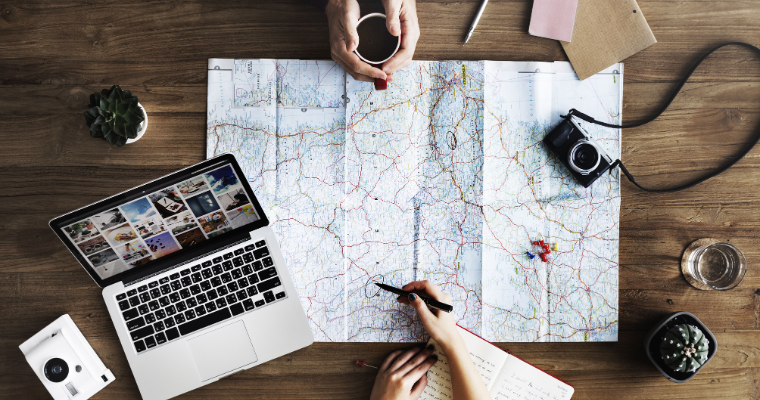Struggling to plan the perfect trip? Knowing how to create an effective travel itinerary can turn your vacation into a smooth, stress-free journey. Whether you’re a seasoned traveler or embarking on your first adventure, planning your trip with a detailed itinerary will save you time, reduce stress, and help you maximize your vacation.
What is Travel Itinerary?
A travel itinerary is a detailed plan that outlines all aspects of a trip, including destinations, transportation, accommodation, activities, and important timings. It serves as a structured schedule that helps travelers stay organized and make the most of their time. A well-prepared itinerary usually includes dates, locations, hotel details, flight or train times, and a list of things to do or see at each destination. This document ensures clarity and reduces the chances of missed bookings or confusion during the trip.
A good traveler has no fixed plans and is not intent on arriving.
Travel itineraries are commonly used by individuals, families, tour operators, and business travelers to manage their journey efficiently. Whether it’s a short weekend trip or a multi-country vacation, having a clear itinerary helps in budgeting, time management, and coordination, especially when traveling with others. Today, many travelers use digital tools and apps to create and access their itineraries, making updates and adjustments easier on the go.
Also read: Best Places to Visit in the US
7 Effective Tips to Create a Travel Itinerary for Any Trip
Here’s how you can create the perfect travel itinerary and make your trip a breeze.
1. Set Clear Goals and Expectations for Your Travel Itinerary
When it comes to planning your trip, the first step is understanding what you want out of it. Are you aiming for relaxation, adventure, culture, or perhaps a mix of everything? Setting clear goals will guide your entire itinerary.
- Leisure and Relaxation
If your goal is to unwind, you’ll want to prioritize activities like spa visits, beach days, or exploring quiet areas like parks or gardens. - Adventure and Exploration
If you crave excitement, you’ll want to focus on high-energy activities like hiking, zip-lining, or skydiving. - Cultural Immersion
Cultural travelers should emphasize museums, historical landmarks, local food experiences, and regional festivals.
Setting clear and realistic goals at the outset of your trip is key to building an itinerary that fulfills your travel desires. It will ensure that your trip is as enjoyable and stress-free as possible, allowing you to focus on the experiences that matter most.
Also, ensure you allocate downtime for relaxation between intense activities.
2. Research Key Details About Your Destination
Once you’ve set your travel goals, it’s time to dive into researching your destination. The more you know about where you’re going, the better prepared you’ll be.
| Focus Area | What to Look For |
|---|---|
| Key Attractions | List top landmarks, cultural sites, outdoor activities, and experiences to prioritize. |
| Activity Alignment | Match activities with your travel purpose—relaxation, adventure, learning, or exploration. |
| Weather Insights | Understand seasonal conditions and forecast to guide packing and scheduling. |
| Local Customs | Be aware of local behaviors, dress codes, and etiquette to show cultural sensitivity. |
| Events and Holidays | Identify festivals, holidays, or local events that could impact or enhance your trip. |
Weather plays a huge role in shaping your trip. Different times of the year bring unique weather conditions, which can drastically affect your travel experience.

Research when your destination has the best weather and avoid extreme seasons that could ruin your plans.
| Season | Best Activities | Potential Risks |
|---|---|---|
| Spring | Sightseeing, hiking, festivals | Mild weather, occasional rain |
| Summer | Beach activities, outdoor adventures | High tourist crowds, heat waves |
| Fall | Wine tours, hiking | Cooler weather, some rainfall |
| Winter | Skiing, mountain resorts | Snowstorms, closed attractions |
The more you research, the more detailed and accurate your itinerary will become.
Make a list of the key attractions that match your interests. Use blogs, social media, and travel forums to get recommendations from other travelers. Also, look for unique, off-the-beaten-path attractions that are less crowded but offer rich experiences.
Conducting detailed research helps you plan effectively, avoid surprises, and enrich your travel experience. Knowing the local culture, weather, and hidden gems ensures that your itinerary is both exciting and realistic.
Also read: How to Become a Travel Agent?
3. Plan Your Itinerary Day by Day
Organizing your trip by individual days helps ensure a balanced schedule. It allows you to make the most of your time without overloading each day.
- Day 1: Arrival
Plan time for airport transfers, check-in, and settling into your accommodation. Keep the evening light—perhaps a nearby restaurant or a short walk—to help you adjust without stress. - Day 2–4: Sightseeing and Activities
Organize the main attractions and experiences during these days. Be strategic with location and timing, and avoid overcrowding your schedule. Leave space between activities for meals, local interaction, or short breaks. - Day 5: Light Exploration
Dedicate this day to less intense activities—local markets, cafes, or cultural spots that don’t require early starts or strict timelines. This helps avoid fatigue while still enjoying the surroundings. - Day 6: Free Day
Leave this day open for anything unplanned. You can revisit a favorite spot, explore something spontaneous, or just relax. This also serves as a buffer for any missed plans from earlier in the trip.
Check if any major events, festivals, or public holidays fall during your travel dates. These can add value to your experience but may also lead to higher prices and larger crowds. Choosing the right travel dates and trip duration is essential. It ensures your plans align with your goals while keeping your schedule stress-free and efficient.
Planning each day with purpose helps you make the most of your time, stay organized, and enjoy the experience without feeling rushed.
4. Optimize Your Itinerary with Travel Apps
Travel apps play a vital role in planning, organizing, and managing your trip efficiently. Instead of juggling paper printouts and scattered emails, apps like Google Trips, TripIt, and Kayak help consolidate your bookings, daily schedules, and reservations in one place.
The best trips aren’t just well-planned—they’re well-managed in the moment.
These tools offer real-time updates, suggest local attractions, and notify you of any changes in flights or hotel bookings. Many also provide offline access, which is especially useful when you’re traveling in areas with limited internet connectivity. Whether you need to find last-minute accommodation, adjust plans on the go, or simply stay on top of your itinerary, these apps streamline the process.
By integrating travel apps into your planning, you reduce stress, save time, and gain flexibility—all of which contribute to a smoother and more enjoyable travel experience.
5. Prioritize Activities and Attractions for a Well-Balanced Travel Itinerary
Planning a trip with so many options can be overwhelming. To maximize your travel experience, prioritize the activities and attractions that align with your goals. This section will guide you on how to prioritize effectively while balancing essential landmarks with more personalized, spontaneous experiences.
Start by listing the activities and attractions that matter most to you. While it might be tempting to fill your itinerary with as many activities as possible, focusing on a select few will help you enjoy each experience more fully without feeling rushed.
- Top Priorities. These include the must-see landmarks or unique experiences central to your trip’s goals. These are the activities you don’t want to miss.
- Secondary Attractions. These are optional activities that can be included if time allows, but they aren’t essential to your trip’s core experience.
While it’s important to visit key landmarks, leave room in your itinerary for spontaneous adventures. Whether it’s stumbling upon a hidden café or discovering street art in an unexpected neighborhood, these unplanned moments often turn into the most memorable experiences of your trip.
By prioritizing essential activities and balancing must-see locations with unplanned exploration, you can create an itinerary that is both efficient and enjoyable. This approach ensures your trip is fulfilling, without the feeling of being overwhelmed by too many destinations or activities.
6. Share Your Itinerary with Travel Companions
If you’re traveling with others, make sure to share your itinerary with them before the trip.

This will help everyone stay on the same page about the schedule, expectations, and goals for the trip.
- Group Travel
For group trips, communicate preferences early to ensure that the itinerary accommodates everyone’s interests. - Solo Travel
Even when traveling solo, it’s a good idea to share your itinerary with friends or family for safety reasons.
Sharing your itinerary helps make sure that everyone is prepared and can contribute their ideas or preferences.
7. Organize Your Itinerary by Location and Time
To make the most of your trip, organizing activities by location and time will minimize transit and maximize exploration.
- Group Activities by Proximity. Plan your day around specific areas to reduce travel time. For example, visit nearby attractions like the Louvre and Musée d’Orsay in Paris on the same day.
- Time Allocation. Allocate enough time for each activity, factoring in possible delays. Be realistic about how much you can do in one day.
- Include Buffer Periods. Add buffer time between activities to accommodate unexpected delays or opportunities.
- Use Digital Tools. Tools like Google Calendar or TripIt help visualize your schedule and keep things organized.
Efficiently planning by location and time makes your itinerary flow smoothly, ensuring a stress-free and enjoyable experience.
FAQ on Travel Itinerary
A travel itinerary is a detailed plan or schedule that outlines your travel activities, including transportation, accommodations, sightseeing, dining, and more. It helps in time management, budgeting, and avoiding missed bookings or experiences.
To create an international travel itinerary, start by listing your travel dates, destinations, visa requirements, flights, hotels, local transport, currency exchanges, and activities for each day. Use travel planning tools like Google Docs, TripIt, or Notion for easy access and updates.
In 2025, leading travel itinerary planning apps include TripIt for organizing confirmations into a master itinerary, Wanderlog for collaborative trip planning, Sygic Travel Maps for detailed maps and offline guides, Hopper for predicting the best times to book flights and hotels, and Skyscanner for comparing prices across airlines and accommodations.
Most first-time travelers to Europe plan for 10 to 15 days, covering 2 to 4 major cities or countries. This allows for a balance of sightseeing, cultural experiences, and relaxation without feeling rushed.
Yes, many websites offer free travel itinerary templates in formats like PDF, Word, or Excel. You can find them on platforms like Canva, Google Docs, or travel blogs with downloadable links.
Final Thought
Creating a well-planned itinerary can be the key to a successful and stress-free trip. By setting clear goals, researching your destination, and building a flexible schedule, you can ensure that your vacation is organized and enjoyable. Don’t forget to leave room for spontaneity and use travel apps to stay organized along the way.



